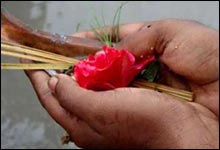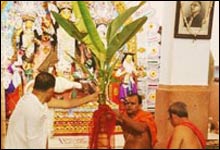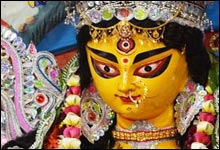Durga - Akalbodhon

The history of Durga Puja dates back in the ancient period. However, there is much debate regarding the origin of Durga Puja. It's history as well is quite complex. The most popular story is found in the Ramayana where Lord Rama of Ayodhya invoked the goddess Durga in his battle against Ravana. Although the goddess was traditionally worshipped in the spring, due to contingencies of battle, Rama had to invoke Goddess Durga in the autumn, hence the akalbodhan was performed by him.
Infact, the term Akaalbodhon can be found in Krittibas' Ramayan and not in the Valmiki Ramayan (the original Ramayan). The term "Akal" means "untimely" and the term "Bodhon" means "awakening" or "invocation".
Ma Durga was untimely awakened from her peaceful slumber by Lord Rama at the time of Ashwin (Autumn) which is considered as an inauspicious time in Hindu mythology.
According to Hindu mythology, the time period between 23rd December and 21st / 22nd June or Spring Equinox (Summer Solstice) is the perfect or the auspicious time for worshipping Gods and Goddesses as they remain awake and active during this time.This is the time of Uttorayan and is popularly known as the Days of the Gods.During this time the days are longer and nights are shorter.The actual worship of the Goddess Durga as stipulated by the Hindu scriptures hence falls in the month of Chaitra, which roughly overlaps with March or April. On the other hand autumn or the time of Dakshinayan is the resting time for Hindu Gods and Goddesses.

Scientifically speaking it is the time for autumnal equinox (Winter Solstice). or the time period between 22nd /23rd June and 22nd December when the sun shines in the southern hemisphere and so it is winter in the northern hemisphere. Days are shorter and nights are longer. It is popularly known as the Nights of the Demons. And since Goddess Durga is invoked at the wrong time, it is called " Akal Bodhon " in Bengali.
The story in Krittibas' Ramayan goes somewhat like this. Lord Rama of Ayodhya led an army of 'Banaras' (Monkeys) to wedge a war against the demon king Ravana who had stolen his wife Sita and had held captive in his palace in Lanka. In the midst of the war Rama suddenly noticed that Ravana is trying to please him by singing in praise for him. This made Rama more disheartened because now as Ravana had become a devotee of Rama, the latter could not kill him. The Gods and Goddesses too become disappointed. All the Gods and Goddesses assembled together and it was decided in the meeting that Goddess Saraswati should reside on the tongue of Ravana, making him say foul words to Rama. As this was done, soon a shaft of words from Ravana's mouth pierced Rama's ears and he at once took up arms against the demon king. The war started again and Ravana was slain into two halves by Rama. But to everyone's surprise, a boon from Brahma revived Ravana and he worshipped Devi Ambika to support him in his battle against Rama. Devi Ambika joined him and sat with him in his chariot.
This made Rama poignant even more for he now knew it was quite impossible for him to kill the demon and rescue Sita. Seeing this, all the Gods and Goddesses now approached to Lord Vishnu who suggested that Rama had to pray for the blessings of Goddess Devi Chandika or Goddess Durga, mother of all, so that she would help him and take no offense in his killings. Rama started worshipping Devi Chandika but the Goddess could not be satisfied by his earnest prayers; she did not appear before Rama. Then Bibhishan suggested Rama that the latter should try once again to appease Goddess Durga by offering 108 blue lotuses.
Summoned by Rama, Hanuman flew to Debidaha, the only place where one could find blue lotuses, and brought back 108 lotuses for his Lord. In halfway of his puja, as Rama was going to offer the flowers to the Goddess, he found out that there were 107 blue lotuses and not 108. Being the human incarnation of Lord Vishnu, Rama had to face the tests of mother superior Durga. To prove his devotion to the Goddess Durga and his intense love for his wife Sita, Rama promptly took his bow and arrow ready to pick one of his eyes - as all know he was born with lotus eyes and everyone regarded them as blue lotus eyes. His decision to pluck his beautiful blue eyes as a substitute for the 108th blue lotus made Devi Chandika or Durga appear in full form before him and stopped him from doing so. Devi Durga granted the boon to Rama that she would leave the side of Ravana so that he could kill the demon and rescue Sita. Rama had started the puja on the 6th day (Shashthi) of Ashwin and the Goddess appeared before him on the 8th day(Astami). At the meeting point between the day of astami(8th) and navami(9th) she entered into Ram's weapons and gave them required strength to kill Ravana. Ravana was killed on the day of Dasami.
There are, however, some other stories behind the commencement of the autumnal worship of Devi Durga. According to Shree Shree Chandi, by orders of medhas rishi, King Surath (in order to get back his lost kingdomand Samadhi Vaishya (in order to gain Brahmagyan) had inaugurated the worship of Devi Durga in autumn .This is the first instance of the Goddess being worshipped in the such a uncustomary time. The next instance tells that Lord Indra performed Akalbodhon or the untimely awakening of Devi Durga in autumn in order to kill Mahisasur. The third time, it was performed by Brahma, just before Rama did with the same purpose as the latter did. Hence we can say that, the story of Devi Durga's Akalbodhon is purely mythical in nature.



